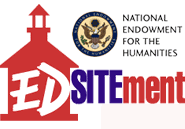 |
 |
| |

|
| |

|
| |
Last names as we know them now originated in the Middle Ages from people’s occupations, where they lived, their father’s first name, or even their appearance or disposition.
|
| |
| |
| Subject Areas |
| Art and Culture
|
| |
Anthropology |
| History and Social Studies
|
| |
World History - Asia/Far East |
| |
World History - Europe |
| |
| Time Required |
| |
Activity 2: 60 minutes |
| |
| Skills |
| |
Interpreting and analyzing written and oral information
Making inferences and drawing conclusions
Vocabulary development
Cross-cultural connections
Research
Working collaboratively
Categorizing
|
| |
| Additional Data |
| |
Date Created: 06/17/03
|
|
What’s In A Name? British Surnames Derived from Places
Introduction:
Over half of all English surnames used today are derived from the names of
places where people lived. This type is known as a locative surname. For example,
a man called John who lived near the marsh might be known as John Marsh. John
who lived in the dell was called John Dell. Other examples are John Brook, John
Lake, and John Rivers. Some names combined two words, such as Underhill (someone
who lived at the foot of the hill) and Hightower (dweller of the high tower).
- Many names had the following endings: -ford (the crossing place in a river or stream), -fort (a fortification), -field (an open area where fairs were held), -brook, -wood, and -well. Ashwood, for example, would describe someone who lived in a wood of ash trees.
Certain locative surnames are less clear in meaning, since they are derived from earlier forms of English. For example, who would guess that Dunlop means “a muddy hill!” Below are a few helpful clues for determining the meanings of this type of name.
- The prefix atte meant “at the.” It appeared in names
like Attewood and Attewater, which later evolved as Atwood and Atwater.
- Frequently used place nouns were den (valley), beck (brook), more (river bank), and adder (stream). Beckford referred to someone who lived near the crossing place of a brook.
- The endings -ton, -ham, -wick, -stow, and -stead meant “farm” or “town.” So the name Denton (den plus ton) referred to someone who lived in a town or farm in a valley.
- Other commonly used place endings were: -don (a hill), -bury (a fortification), -leigh or -ley (a clearing), and -chester (site of an ancient Roman fort).
In some cases, the preposition "of" was simply added to the name of a town to form a person's byname. Examples are John of York and William of Orange.
Guiding Question:
What are locative surnames?
Learning Objectives:
Students will develop an understanding of British surnames derived from locations and learn some of the more common names still prevalent today.
Instructional Plan:
- After discussing the above information with your students (you might wish
to list certain items on the board), return to the Surname
Origin List. Instruct the students, working in pairs, to look up the meanings
of the names on the chart (Locative
Surnames) also available in pdf format.
Student Activity:
| Name
|
Meaning |
| 1. Armstrong |
1. |
| 2. Black |
2. |
| 3. Fairchild |
3. |
| 4. Giddy |
4. |
| 5. Green |
5. |
| 6.Merry |
6. |
| 7. Noble |
7. |
| 8. Sharp |
8. |
| 9. Truman |
9. |
| 10. White |
10. |
Assessment:
- Review the key concepts covered in this activity. Call upon students to
suggest place nouns commonly used as roots or suffixes of British locative
surnames. Then have each student write down a list of five locative surnames
not previously mentioned.
- As a follow-up, you might play “What's My Name?” Call upon a student
to draw a figure on the board to illustrate one of the names on his list.
For example, he might draw a picture of a church on a hill to represent “Churchill.”
Whoever guesses the name gets to go next. Continue the game until everyone
has had a turn.
Selected EDSITEment Websites
Other Information
Standards Alignment
- NCSS-1
Culture and cultural diversity. more
- NCSS-2
Time, continuity, and change. The ways human beings view themselves in and over time. more
- NCSS-3
People, places, and environments. more
- NCSS-9
Global connections and interdependence. more
- NCTE/IRA-6
Students apply knowledge of language structure, language conventions (e.g., spelling and punctuation), media techniques, figurative language, and genre to create, critique, and discuss print and nonprint texts. more
- NCTE/IRA-7
Students conduct research on issues and interests by generating ideas and questions, and by posing problems. They gather, evaluate, and synthesize data from a variety of sources (e.g., print and nonprint texts, artifacts, people) to communicate their discoveries in ways that suit their purpose and audience. more
- NCTE/IRA-8
Students use a variety of technological and information resources (e.g., libraries, databases, computer networks, video) to gather and synthesize information and to create and communicate knowledge. more
- NCTE/IRA-9
Students develop an understanding of and respect for diversity in language use, patterns, and dialects across cultures, ethnic groups, geographic regions, and social roles.
- NGS-10
The Characteristics, Distribution, and Complexity of Earth’s Cultural Mosaics
- NGS-4
The Physical and Human Characteristics of Places
- NGS-9
The Characteristics, Distribution, and Migration of Human Population on Earth’s Surface

|


